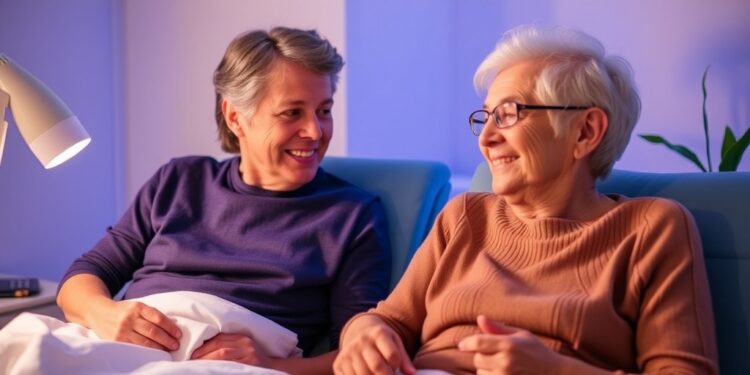Blue-enriched light has emerged as a formidable foe in the ongoing battle against age-related sleep disturbances, according to groundbreaking research conducted by scholars at the University of Surrey. As adults reach their golden years, many experience alterations in their sleep patterns, leading to challenges such as difficulties in falling asleep, frequent awakenings throughout the night, and overall compromised sleep quality. This new research provides a beacon of hope, revealing how targeted light therapy, specifically blue-enriched light, can significantly enhance both sleep and daytime activity among older adults living independently.
The research unveiled a crucial link between age-related changes in visual perception and the disrupting effects of artificial light exposure, particularly in environments such as care homes. With reduced mobility and diminished social interactions, older adults are increasingly deprived of natural daylight, which is essential for regulating circadian rhythms. The scarcity of natural light coupled with excessive artificial light exposure during the evening contributes to a cycle of poor sleep that exacerbates health deterioration in this demographic.
The findings painted a clear picture—timing matters profoundly when it comes to light exposure. Blue-enriched light emerged as a genuine ally when used in the morning, promoting greater alertness, enhanced mood, and increased activity levels during the day. However, the results also indicated potential risks; exposure to this type of light during evening hours proved counterproductive, leading to extended periods of wakefulness and increased restlessness at night. Such conclusions underscore the necessity of understanding the circadian timing involved in light exposure and its physiological effects on an aging population.
Dr. Daan Van Der Veen, a Senior Lecturer in Sleep and Chronobiology at the University of Surrey, emphasized the significance of these findings. He articulated that carefully timed light interventions could serve as an effective and non-invasive method for bolstering sleep quality and daytime functioning among older adults. By strategically harnessing the power of blue light in the morning, we can potentially facilitate healthier sleep patterns and improve overall quality of life for our aging population.
This pioneering study fills a research gap, shedding light on the effects of self-administered light therapy specifically tailored for healthy older adults living independently. Débora Constantino, a Postgraduate Research Student involved in the study, expressed enthusiasm about the implications of the findings, attributing a vital role to accessible and affordable light therapies in combating the pervasive issue of age-related sleep disturbances without the need for pharmacological interventions.
Historically, sleep disturbances in older adults have been inadequately addressed, often relegating the aging population to reliance on medications, which can have associated side effects and dependency risks. The ability to utilize light therapy—a simple, low-cost intervention—could revolutionize how we approach sleep health in older adults, leading to more enduring and beneficial lifestyle changes.
Moreover, the implications of these findings extend beyond mere sleep improvement; increased daytime activity and regular sleep patterns have been associated with broader health outcomes, including reduced risks of chronic diseases and improved mental health. Thus, light therapy represents a practical intervention not only for sleep but also for enhancing the overall well-being of older adults.
The study presents an accessible roadmap for caregivers, family members, and the health community to implement light-based interventions aimed at promoting health and well-being in older adults. By prioritizing morning light exposure and encouraging outdoor activity, families and caregivers can support a healthier lifestyle for their loved ones, diminishing the debilitating effects of aging on sleep.
In conclusion, this research heralds the potential of light therapy as a non-invasive mode of intervention for enhancing sleep and activity among older adults. As the peer-reviewed findings resonate through academic circles and health policy discussions, practical measures could soon follow, leading to novel strategies designed to harness the fundamental essence of light to improve life quality in an aging society. This exploration stands as a vital reminder of the simple yet profound impact of our environments on health and well-being.
Subject of Research: Blue-enriched light therapy and its impact on sleep quality and daily activity in older adults.
Article Title: Blue-Enriched Light Therapy: A New Hope for Improving Sleep in Older Adults
News Publication Date: [Insert Date]
Web References: [Insert Relevant Links]
References: [Insert Relevant Cited Works]
Image Credits: [Insert Relevant Credits]
Keywords
Light Therapy, Sleep Quality, Older Adults, Blue-Enriched Light, Circadian Rhythms, Daytime Activity, Non-Pharmacological Interventions, Aging, Health Enhancement, Sleep Disorders, University Research, Independent Living
Tags: age-related sleep disturbancesbenefits of natural light exposureblue light therapy for sleep improvementblue-enriched light for better sleepcircadian rhythm regulation in elderlyeffects of artificial light on sleepenhancing daily activity levels in seniorslight therapy for independent living seniorsresearch on sleep disorders in older adultssleep quality in older adultsUniversity of Surrey sleep studyvisual perception changes with age





